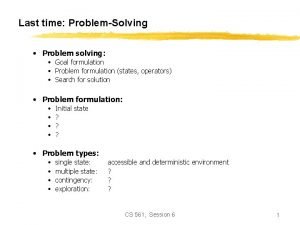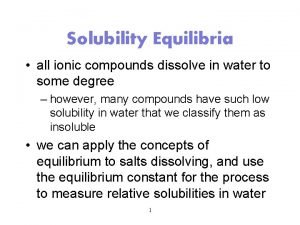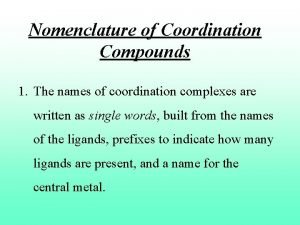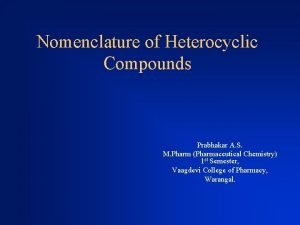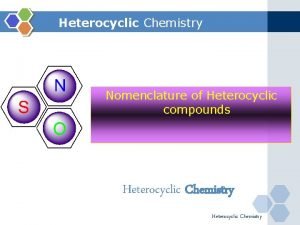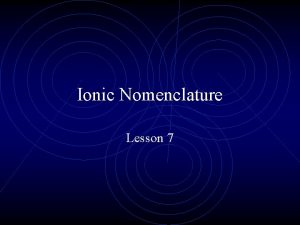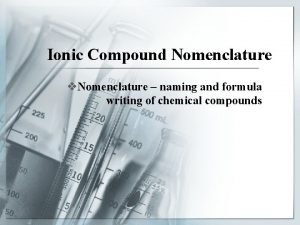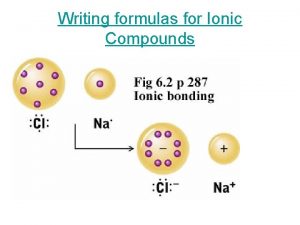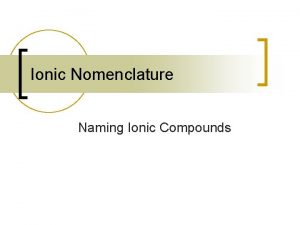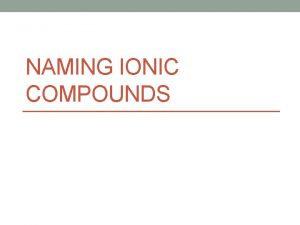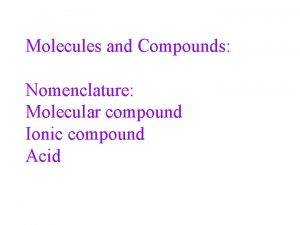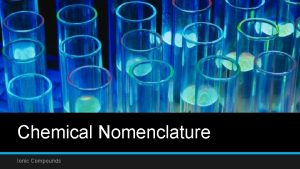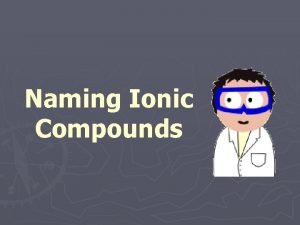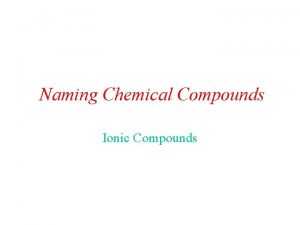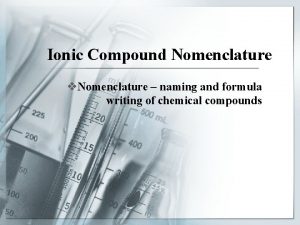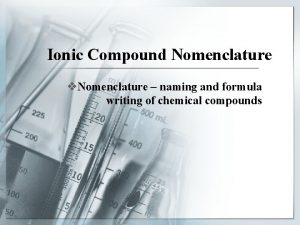IONIC COMPOUND FORMULATION NOMENCLATURE All ionic compounds consist












- Slides: 12

IONIC COMPOUND FORMULATION & NOMENCLATURE

• All ionic compounds consist of two parts: a cation (a positive ion) and an anion (a negative ion). • Ions are combined in simple, whole-number ratios to balance their charges. This results in a net charge of zero, which all ionic compounds MUST have. • The “cross technique” is used to create the correct ratio of ions needed. Example: aluminum (Al+3) and oxygen (O-2). +3 -2 Al O 1. Write the symbols, then write the charges on each symbol (from ion list) +3 Al 2 -2 O 3 2. Cross the charges, dropping the + and – symbols (don’t write 1 s) Al 2 O 3 3. Clean up the formula (completely erase all charges) and reduce if necessary. So when do you need to reduce?

• Here’s two examples of when the ratio needs to be reduced: +2 -2 Ca O Ca 2 O 2 +4 -2 Sn S Sn 2 S 42 Ca. O Sn. S 2 • Let’s try formulating some compounds (putting them together):

• Let’s try formulating some compounds (putting them together): magnesium fluoride Mg. F = 2 _______ Fe. Br 3 2. iron (III) bromide = KCl Ca. Cl 2 ________ Ag 3 N= 3. potassium chloride _______ +2 Let’s try naming some compounds: +3 calcium chloride = 1. 4. Fe. O __________ 2. Al 2 O 3 _________ 5. silver nitride = +2 3. K 2 O____________________ 6. 4. Pb. O 2 _________ 9. 5. K 2 S __________ 10. Zn. Cl 2 __________ 1. Mg Ca Fe F Cl tin (II) sulfide = __________ 7. barium phosphide = ________ 8. cobalt (III) oxide = _________ - (I) iodide+= 9. copper 6. Mn 3 P 2 __________ 7. Na 2 S__________ 10. lead (IV) selenide= + -3 8. Ag 2 S __________ Br K Cl Ag N Cu 3 N __________ MONATOMIC

• Let’s try formulating some compounds (putting them together): magnesium fluoride Mg. F = 2 _______ Fe. Br 3 2. iron (III) bromide = KCl Ca. Cl 2 ________ Ag 3 N= 3. potassium chloride _______ +2 -2 Let’s try naming some compounds: +2 calcium chloride = 1. 4. Fe. O __________ 2. Al 2 O 3 _________ 5. silver nitride = + 3. K 2 O____________________ 1. Sn S Ba Cu I tin (II) sulfide =Sn 2 S 2 Sn. S Ba 3 P 2 __________ Co=2 O 3 7. barium phosphide Cu. I ________ 8. cobalt (III) oxide. Pb = 2 Se 4 Pb. Se 2 _________ -3 (I) iodide+3 -2 9. copper = 6. Mn 3 P 2 __________ 7. Na 2 S__________ 10. lead (IV) selenide= +4 -2 8. Ag 2 S __________ 6. P Co Pb Se O 4. Pb. O 2 _________ 9. 5. K 2 S __________ 10. Zn. Cl 2 __________ Cu 3 N __________ MONATOMIC

• Ionic compounds are named with the following rules: • The cation name goes first, the anion name goes second. • cations are usually metals. The name of the cation does not change from the name of the element. Zn+2 = zinc Sc+3 = scandium Fe+2 = iron (II) Fe+3 = iron (III) • Note: If the element is polyionic (meaning it can have more than one type of charge), this must be indicated by placing a roman numeral after the name to indicate the size of the charge. • anions are a single negatively charged element (monatomic)—name of element with ending taken off and “-ide” added.

• Let’s try formulating some compounds (putting them together): 6. tin (II) sulfide =Sn 2 S 2 Sn. S 1. magnesium fluoride Mg. F = 2 Ba 3 P 2 __________ Fe. Br 3 Co=2 O 3 7. barium phosphide 2. iron (III) bromide = KCl Cu. I ________ Ca. Cl 2 ________ 8. cobalt (III) oxide. Pb = 2 Se 4 Pb. Se 2 Ag 3 N= 3. potassium chloride _________ 9. copper (I) iodide =(II) phosphide calcium chloride 1. 4. Fe. O __________ 6. Mn __________ iron (II) =oxide 3 P 2 manganese ________ Let’s try naming some compounds: _________ 2. Al 2 O 3 _________ 7. Na 2 S__________ aluminum oxide sodium sulfide 10. lead (IV) selenide= 5. silver nitride = 3. K 2 O__________ 8. Ag potassium oxide silver sulfide 2 S ____________________ 4. Pb. O 2 _________ lead (IV) oxide 9. 5. K 2 S __________ potassium sulfide 10. Zn. Cl 2 __________ zinc chloride Cu 3 N __________ copper ( I) nitride

COVALENT BONDING CHARACTERISTICS AND NOMENCLATURE

• Covalent compounds share electrons, (ionic bonds transfer them). • Covalent bonds = two nonmetals, or a nonmetal and a metalloid. Remember, hydrogen is not an alkali metal, it is a nonmetal. • Remember, ionic bonds always contain a metal. Metals never appear in covalent compounds!!! • • Covalent bonds rely on the “octet rule, ” meaning that atoms in a covalent bond need 8 electrons around them (in most cases). • covalent bonds can be single, double, or triple, in order to satisfy the octet rule. 1 triple 4 singleshow 2 double CO 2 the arrangement N 2 eight electrons • CF Lewis-dot structures of these 4 bonds F F C F F O C O N N

• covalent compounds can involve the same elements with multiple ratios (such as C 3 H 8, C 2 H 4, NO 2, N 2 O), so the ratio in the compound must be shown in the name. • to write the name of a covalent compound, we use Greek prefixes: • attach the appropriate prefix to the name of each # Prefix element in the compound. (Note: if the first 1 monoelement in the compound is single, you do not need 2 dithe prefix “mono-. ” “Mono-” is only used on the 3 trisecond element!) • the ending of the second element’s name is taken off, 4 tetra 5 pentaand “-ide” is added. • if you get any of the following vowel combinations in 6 hexathe name when you add the prefix: “oo, ” “ao, ” 7 hepta“oa, ” or “aa, ” that’s not allowed! Drop the vowel off 8 octaof the prefix, and then add it to the name. 9 nona • for diatomic gases, like O 2, name the element, then 10 decaadd the word “gas. ” Therefore, O 2 = oxygen gas

• Let’s try a few: 1. C 2 N 6 = ___________ dicarbon hexanitride 2. P 3 O 7 = ___________ triphosphorus heptaoxide heptoxide 6. no AO combo! no OO H 2 O = ___________ monooxide dihydrogen monoxide combo! no OA B 5 As = ___________ monoarsenide combo! pentaboron monarsenide N 2 = ____________ nitrogen gas (diatomic gas!) trisulfur tetrachloride = ______ S 3 Cl 4 7. carbon monoxide = ______ CO 8. Cl 2 (diatomic gas!) chlorine gas = ______ 3. 4. 5. 9. 10. Si. Br 5 silicon pentabromide = ______ Cl 4 Br 10 tetrachlorine decabromide = ______

Can you tell the difference between an ionic compound a covalent compound based on the name or formula alone? You need to be able to do so! Place an “I” or a “C” in the blank: I 1. Fe 3 N 2 ___ I 2. K 2 S ___ C 3. NH 3 ___ C 4. Br 2 ___ I 5. Mn 2 O 3 ___ I 6. Ca. O ___ I 7. Li 2 O ___ C 8. carbon dioxide ___ I 9. aluminum nitride ___ I 10. tin (II) sulfide ___ C 11. chlorine gas ___ I 12. calcium sulfide ___ I 13. cobalt (III) oxide ___ I 14. sodium phosphide ___
 Nomenclature of binary ionic compounds
Nomenclature of binary ionic compounds Metallic bond facts
Metallic bond facts Why problem formulation follow goal formulation
Why problem formulation follow goal formulation Do all ionic compounds dissolve in water
Do all ionic compounds dissolve in water What does n mean in nomenclature
What does n mean in nomenclature Coordination compound nomenclature
Coordination compound nomenclature Heterocyclic compounds nomenclature
Heterocyclic compounds nomenclature Fused ring nomenclature
Fused ring nomenclature Ionic nomenclature
Ionic nomenclature Rb3p compound name
Rb3p compound name Opposite rays
Opposite rays Criss-cross method steps
Criss-cross method steps Ternary ionic compounds
Ternary ionic compounds


